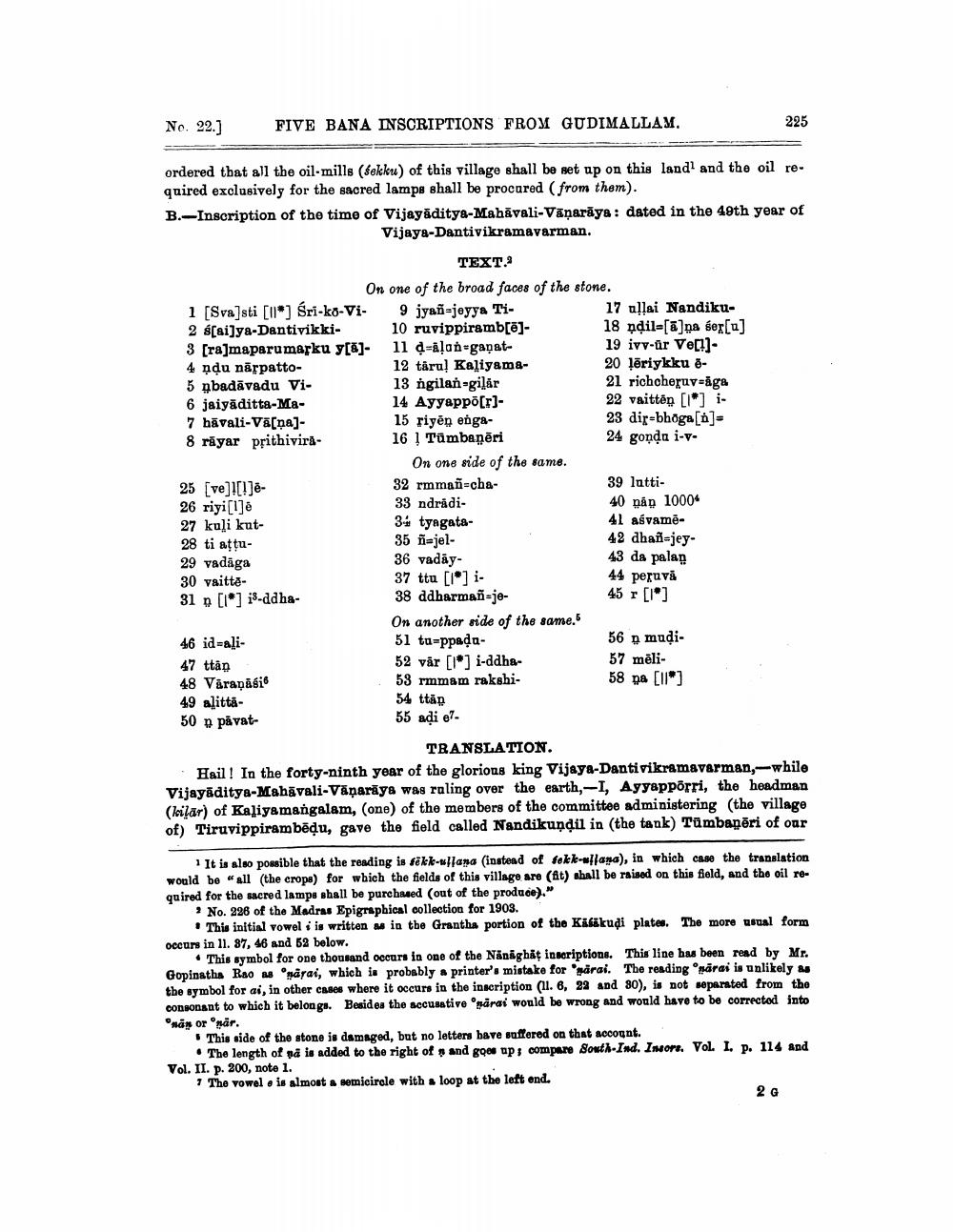________________
No. 22.]
FIVE BANA INSCRIPTIONS FROM GUDIMALLAM.
225
ordered that all the oil-mills (tekku) of this village shall be set up on this land and the oil required exclusively for the sacred lamps shall be procured (from them). B.-Inscription of the time of Vijayaditya-Mahāvali-Vānariya: dated in the 49th year of
Vijaya-Dantivikramavarman.
TEXT.
On one of the broad faces of the stone. 1 [Sva]sti [11*) Śri-ko-Vi- 9jyañ-joyga Ti
17 allai Nandiku2 ssai]ya-Dantivikki- 10 ruvippiramb[8]
18 ndil-[7]na ser[u] 3 [ra]maparumafku y[8]- 11 d=aļon=ganat
19 ivv-or Ve[?]4 ndu nārpatto12 tāru! Kaliyama
20 ļēriykku e5 abadāvadu Vi13 ngilan-gilar
21 richcheruvsåga 6 jaiyāditta-Ma14 Ayyappo[r]
22 vaittên [18] i 7 hāvali-Va[na]15 riyèn enga
23 dir=bhoga[0]= 8 rāyar prithivira16 | Tumbaņēri
24 gonda i-v
On one side of the same. 25 [ve][!]e32 rmmañ-cha
39 latti26 riyi[1] 33 ndrådi
40 nap 1000+ 27 kuli kut3-4 tyagata
41 aśvame28 ti attu35 najel
42 dhanajey29 vadäga 36 vadãy
43 da palap 30 vaitte37 ttu [lo] i
44 peruvi 31 n [1*] is-ddha38 ddharman-je
45 r [1] On another side of the same. 46 id=ali51 tu-ppada
56 o mudi47 ttan 52 vår [lo] i-ddha
57 mēli48 Vårapāśio 53 rmmam rakshi
58 na [ll] 49 alitta
54 ttap 50 p påvat
55 adi e
TRANSLATION. Hail ! In the forty-ninth year of the glorious king Vijaya-Dantivikramaverman,-while Vijayāditya-Mahāvali-Vāņarāys was ruling over the earth,-I, Ayyapporri, the headman (kisar) of Kaliyamangalam, (one) of the members of the committee administering (the village of) Tiruvippirambēļu, gave the field called Nandikundil in (the tank) Tumbaņēri of our
It is also possible that the reading is fékk-ullana (instead of fekk-wllana), in which case the translation would be "all (the crops) for which the fields of this village are (it) shall be raised on this field, and the oil required for the sacred lamps shall be purchased (out of the produce)."
* No. 226 of the Madras Epigraphical collection for 1903.
• This initial vowel i is written m in the Grantha portion of the Kifikudi plates. The more usual form occurs in 11. 87, 46 and 52 below.
• This symbol for one thousand occurs in one of the Nånaghat inscriptions. This line has been read by Mr. Gopinatha Rao usarai, which is probably a printer's mistake for gårai. The reading sarai is unlikely sus the symbol for ai, in other cases where it occurs in the inscription (11. 6, 32 and 80), is not separated from the consonant to which it belongs. Besides the accusative garai would be wrong and would have to be corrected into nag or när.
This side of the stone is damaged, but no letters have suffered on that account.
• The length of på is added to the right of 5 and ge up: compare South-Ind. Insors. Vol. I. p. 114 and Vol. II. p. 200, note 1. 1 The vowel is almost a semicircle with loop at the left ond.
2G




